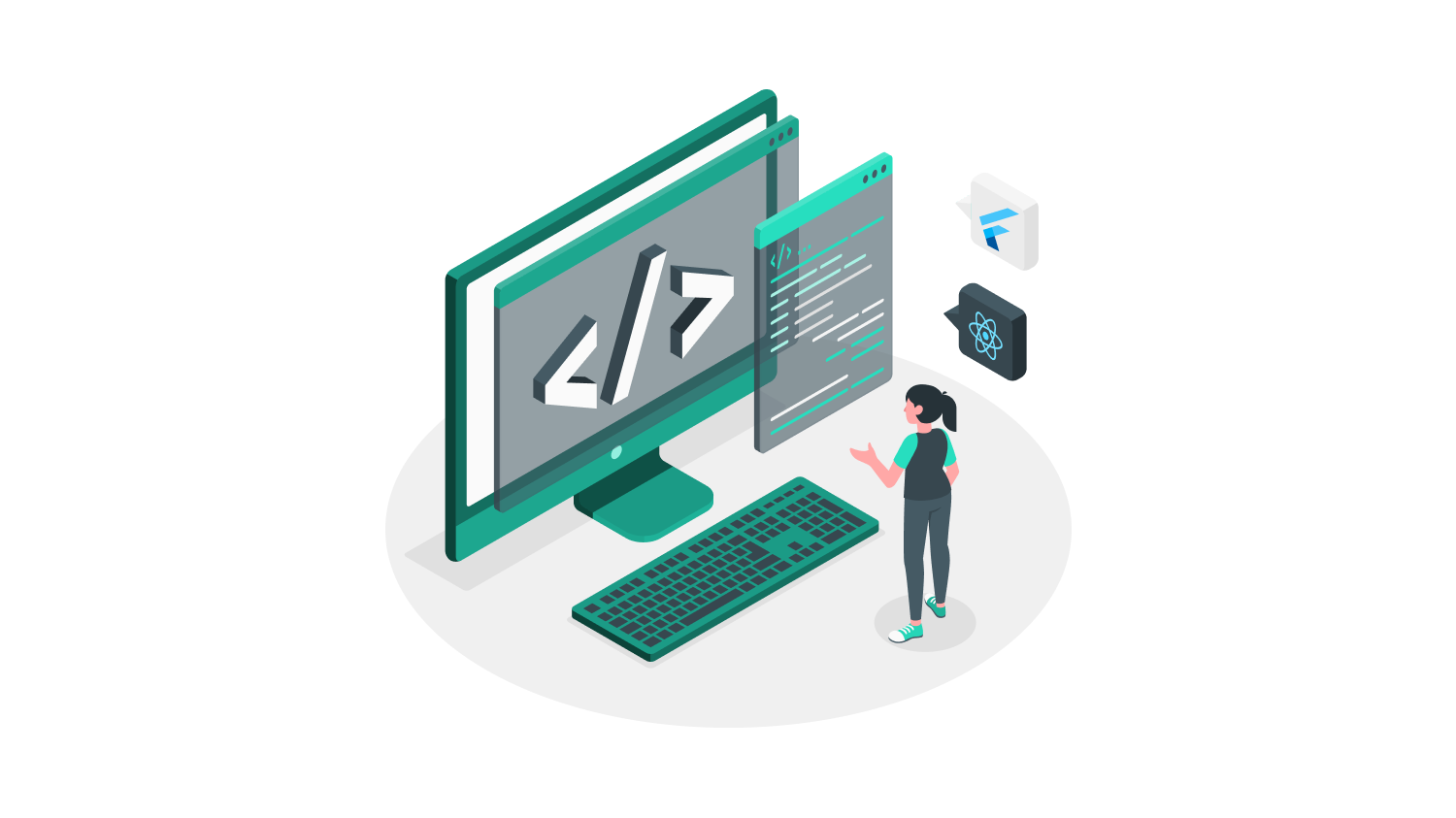According to intexsoft.com, more than 65% of smartphone users in the U.S are iOS users. So, when you build mobile apps, it is required to release versions on iOS and Android devices.
But, building platform-specific apps (native apps) is time-consuming and also costly, so this is where you can turn to cross-platform development. It allows you to create apps for both the platforms by using a single codebase.
And these Flutter and React Native are the two most popular, powerful, and feature-rich open-source frameworks that have the ability to build powerful cross-platform apps, which give you the look and feel of native apps.
So, the question is: which one will you choose for your project? React Native or Flutter?
To select the best one suited for your project, you need to consider the several aspects of both frameworks carefully.
So, keep reading to know more about both app development frameworks. Or Book A Time With Our Tech Experts to discuss your business requirements as early as possible.
What is Flutter?
Flutter is a reactive cross-platform mobile-development framework launched by Google in 2018 and uses Google Dart language. It comes with a robust and comprehensive Software Development Kit (SDK) furnished with UI widgets and tools.
Earlier, it was used for building web apps, but later, it has remarkably evolved and is now used to develop mobile apps for iOS and Android, and also to create software for computer OS like Windows, MacOS, Linux, and Fuschia-a new OS in development from Google.
Google’s strong support helped Flutter quickly catch up to other cross-platform options like React Native.
The Flutter applications are compiled using the C/C++ library. So that it’s closer to machine language and gives the user a better native performance.
According to LinkedIn’s report, Flutter is the fastest-growing and was listed as one of the most loved developer frameworks. Google Ads, eBay Motors, Xianyu, etc., are the popular apps made with Flutter.
Let us discuss some of its pros and cons:
Pros of Flutter
- It can get a near-instant reflection of changes, that is Hot Reload. Hot reload lets developers make changes to the codebase. With this feature, you don’t have to restart the app to see the difference.
- As it has the same codebase for iOS and Android platforms, you need to debug only once instead of separately for each platform.
- It offers high security and scalability.
- It has its own custom widgets and doesn’t use native system components. Also, it has a user-friendly UI. The distinct and beautiful look gives Flutter a significant advantage over React Native.
Flutter’s advantages made it surpass React Native in popularity and community support. It currently has 102,000+ stars on Github, while React Native has 92,200+ stars.
Cons of Flutter
While Flutter is getting popular amongst the cross-platform development tools available out there, it has some cons also:
- One of the cons is the use of Dart language. To develop apps on Flutter, you need someone who knows this particular language. While in the case of React Native, you could quickly get someone who knows the common language, JavaScript, to develop your project. Fortunately, at NeoITO, you will find an expert team of Flutter app developers for your project.
- There is a lack of support for continuous integration.
- It has weak iOS feature support.
- Compared to React Native, it has a limited set of tools and third-party libraries.
- Lack of password manager support.
- Installation of Flutter is a bit more complicated and time-consuming.
What is React Native?
React Native was introduced by Facebook in 2015 and it had the 2nd highest number of contributors in 2018. However, today, various leading individuals and companies such as Microsoft, Callstak, Expo, and Software mansion worldwide support React Native.
And if we talk about its popularity, it has given the world the most popular and amazing applications like Facebook, Pinterest, Instagram, Uber Eats, and more.
Now, lets discuss some of its pros and cons.
Pros of React Naive
- React Native comes loaded with a rich set of debugging and error-reporting tools.
- It offers hot-reloading features that allow changes in codes to take effect immediately in iOS and Android apps. So that you can see the changes immediately.
- It is easier to install than Flutter.
- React native holds a large and robust ecosystem of UI libraries. These libraries provide the same UI experience based on the platform to which you are building to.
- It is entirely free-to-use than using other options like an app builder or no-code solutions for your cross-development needs.
Cons of React Native
- For many developers, it is not convenient to use the debugging tool “Chrome debugger” for editing, code inspecting, etc.
- It can cause a little slower performance for some apps as it doesn’t offer support for parallel threading and multi-processing.
- React Native excels in performance compared to most other cross-platform development frameworks, but it is not as good as native apps development that uses platform-specific tools and languages
Now let’s get started with a detailed comparison.
Flutter Vs. React Native: Comparison
Programming Language
Flutter uses highly expressive Dart, which is an object-oriented programming language. As a result, it can allow more expressive coding. This is why Flutter is frequently used for creating desktop, mobile, and web applications.
On the other hand, React Native uses JavaScript, which is known for dynamic coding. Since React Native uses JavaScript, it is one of the most preferred software development languages. JavaScript still holds its importance in modern app developments.
It is considered as a default language for almost every browser; that’s why many people prefer to hire React Native development company.
Learning Curve
Flutter is comparatively a new language. So, this language requires additional learning efforts to understand its aspects. But, at the same time, React Native is based on JavaScript, which has been around for years. Therefore a large number of developers are familiar with it.
Architecture
Flutter provides all the UI components out of the box. It doesn’t need a bridge for connecting with the native UI layer. It incorporates platform-specific Cupertino and Material design UI elements by using the Skia engine.
This ensures the optimum stability for Flutter apps compared to React Native. Besides, the process of coding is faster.
While React Native has to use the JavaScript bridge to the native UI modules, it eases the communication with the Native UI through JSON messages. These messages are asynchronous, and it results in a smooth animation.
However, compared to Flutter, the user interface performance have some issues like delays in rendering. As flutter doesn’t have this bridge, it doesn’t have this issue.
APIs and UI
Flutter has a richer set of possibilities at this point. It offers a robust repository of API tools and so many ready-to-use User Interface components. Additionally, Flutter offers UI rendering widgets for both Android and iOS.
Regardless of connecting the iOS and Android Native environments through JavaScript bridge, React Native depends too much on third-party libraries. On the other hand, React Native components can show inconsistent behaviour across different platforms.
Development Tools and Documentation
Flutter has rich documentation. It offers detailed guides accompanied by graphics and video tutorials. Also, Flutter has several tools to assist you in app development, including a debugger and Flutter inspector.
On the other hand, React Native has decent documentation and it is more focused on mature web developers who are already familiar with JavaScript. For example, key features like navigation aren’t well-documented. Besides that, finding information about building native libraries can be troublesome.
Code Reusability
Since Flutter provides its own widgets with its own high-performance rendering engine, code reusability is much quicker and highly flexible.
Cost to Develop app
Even if you choose Flutter or React Native, choosing a reliable outsourcing partner can help you develop your product at an affordable cost. However, the cost can vary depending upon the experience of the software development team you hire.
Reach of the App
Cross-platform apps are intended to reach wider audiences through multiple platforms as compared to native apps. Depending on how you use the framework and its UI components to design the unique app, it can reach wider.
So, who is the winner?
In the Flutter Vs. React Native battle; there are no winners or losers. Both frameworks have their own strong and weak sides. And for different problems, each one of them remains a great solution.
When can you choose React Native for your project?
React Native is an ideal framework for developers that are versed with JavaScript coding skills. You can use React Native for creating complicated and demanding apps on both Android/iOS platforms.
See How to Make An App for Android and iOS Using React Native.
When NOT to Choose React Native?
If:
- your app requires to handle less common, or ultra-specific tasks like calculations in the background,
- you need custom communication through Bluetooth,
- you want to make an app for Android only. But if you want to develop an iOS app and know JavaScript, you can consider React Native.
When Can You Choose Flutter For Your Project?
Flutter becomes a perfect tool for iterative development due to its built-in native components and hot reload feature.
You can choose Flutter when you need to create an MVP in a short period. The great UI and its rapidly growing community and library support are valid reasons to choose Flutter. So, for limited budget app projects that need to ensure consistent UI across the mobile and web platforms, Flutter is an ideal solution.
When NOT to Choose Flutter?
If:
- Your app needs to support 3D Touch. Presently, Flutter doesn’t support 3D, but it features on the Flutter team’s long-term roadmap,
- The app needs multiple interactions with an OS, or if you only need little native code to work on flutter you can use the bridge to connect with your native code as you do in React Native.
- You need a minimalistic UI but want to rely on significant use of the phone hardware. Like, if you need to do screen recording.
Also Read: 21 Mobile App Development FAQs Every Startup Founder Must Know – A Detailed Guide
Conclusion
Flutter and React Native are equally useful, show higher performance, and are robust frameworks used across all kinds of mobile app projects. But to choose between the two, you should carefully evaluate the necessities of your app project.
So, if you are looking to build a great cross-platform mobile app that remains an excellent solution to your customer’s problem, approach our tech experts at NeoITO. We don’t just build products; we help evaluate your business needs and goals and choose the right technology to help you grow your business.




